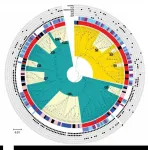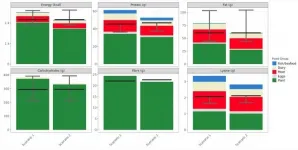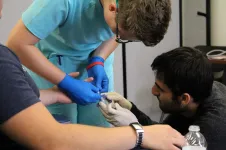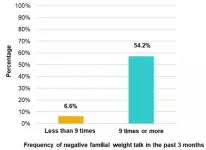From meat-production to urinary tract infections
Epidemiological study revealed that Staphylococcus saprophyticus causing urinary tract infections can have origin in food
2021-06-07
(Press-News.org) In young women, Staphylococcus saprophyticus is a main cause of urinary tract infections (UTI), reaching 20% prevalence. Understanding the epidemiology of this microorganism can help identify its origin, distribution, causes, and risk factors. Now, ITQB NOVA researchers led by Maria Miragaia showed evidence that Staphylococcus saprophyticus can originate in food, namely in the meat-production chain.
Europe is the world's second-biggest producer of pork, the most favored meat type in these countries. One of the contaminants of that meat is S. saprophyticus, which is found also in the environment, the gut and rectal flora of pigs, and in the human gastrointestinal tract, vagina, and perineum.
In the study published in the journal Emerging Infectious Diseases, by using a combination of phenotypic, genomic, and pan-genome wide association approaches, researchers identified two different lineages (G and S) of S. saprophyticus. The lineage G, from food origin and transmitted to humans by contact with food products, and lineage S, from human origin. Both are associated with disease and may be transmitted directly or indirectly between persons within the community, showing not only a local but an extensive geographic distribution.
In order to understand if these bacteria causing urinary tract infections could be related to the ones in pork, the research group looked at S. saprophyticus from a slaughterhouse and compared them to those causing human urinary tract infections. The team analysed bacteria collected from UTI worldwide over 20 years, and from UTI and pork meat production chain in Portugal.
The results revealed that bacteria from the slaughterhouse (equipment, meat, workers colonisation) were similar to human UTI bacteria and had the same antibiotic resistance profile. Although S. saprophyticus pig's colonisation rate was extremely low (1%), 35% of slaughterhouse samples were contaminated. The presence of an antiseptic resistance gene (qacA) by all the lineage G bacteria could be part of the explanation for the ineffective cleaning procedures that were used. "S. saprophyticus strains of animal origin (lineage G) enters the slaughterhouse through food animals, persist on the equipment, disseminate and contaminate the meat processing chain and humans. Human colonization is a crucial step for the later occurrence of UTI", explains Opeyemi Lawal, first author of the study developed during his PhD.
Additionally, by studying genomic data of bacteria collected from patients attending three hospitals in the Lisbon area, the researchers were able to clearly understand that the transmission of these pathogenic bacteria from both lineages (G and S) occurs between persons within the community. With this deep-structured analysis, researchers were also able to identify putative new virulence factors for this unexplored bacterium. The team will continue to search for reservoirs of this bacterium in humans and animals, and to study the mechanisms of S. saprophyticus dissemination and disease to provide the groundwork towards strategies to combat this pathogen, "This a clear example of how food manipulation can impact in human health, and how important it is to educate consumers regarding good individual hygiene practices to avoid spreading of infectious diseases", says Maria Miragaia, head of the Bacterial Evolution and Molecular Epidemiology Lab. "This adds to the list of bacteria that are transmitted to humans through contact with animals and animal-derived food. But the exact mechanisms associated to the conversion from a colonizer to an infectious agent remains to be clarified", adds Henrik Westh from the Copenhagen University Hospital - Amager and Hvidovre, University of Copenhagen (Denmark).
INFORMATION:
The research was developed in collaboration with ITQB NOVA PI Hermínia de Lencastre, Henrik Westh from Copenhagen University Hospital - Amager and Hvidovre, University of Copenhagen (Denmark) and Maria João Fraqueza, from the Centre for Interdisciplinary Research in Animal Health (Faculdade de Medicina Veterinária - Universidade de Lisboa), together with researchers and doctors from the Portuguese hospitals Hospital da Luz, Hospital Egas Moniz, and SAMS Hospital, and from the Hospital Universitari de Bellvitge (Spain) and the Narodowy Instytut Leków (Poland).
The work was supported by FCT (Fundação para a Ciência e Tecnologia), and performed within the projects funded by FEDER funds through COMPETE2020 - Programa Operacional Competitividade, funding MOSTMICRO Research Unit and by ONEIDA project co-funded by FEEI - "Fundos Europeus Estruturais e de Investimento" from "Programa Operacional Regional Lisboa2020".
[Attachments] See images for this press release:

ELSE PRESS RELEASES FROM THIS DATE:
2021-06-07
BOSTON - Current guidelines recommend stopping cervical cancer screening at age 65, but women over age 65 make up over one in five new cervical cancer diagnoses, and are twice as likely to die after a cervical cancer diagnosis compared to younger women. New research from Boston Medical Center found that fewer than one in three women aged 64 to 66 met the criteria to discontinue cervical cancer screening while looking at patients with both private insurance and from a safety-net hospital setting. Published in Gynecologic Oncology, researchers found that even among women with 10 years of continuous insurance coverage, ...
2021-06-07
GAINESVILLE, Fla. --- A more reliable way of estimating the size of megalodon shows the extinct shark may have been bigger than previously thought, measuring up to 65 feet, nearly the length of two school buses. Earlier studies had ball-parked the massive predator at about 50 to 60 feet long.
The revised estimate is the result of new equations based on the width of megalodon's teeth - and began with a high school lesson that went awry.
Victor Perez, then a doctoral student at the Florida Museum of Natural History, was guiding students through a math ...
2021-06-07
PHILADELPHIA (June 7, 2021) - An article written almost 30 years ago helps frame social constructs around the COVID-19 pandemic. By reviewing the essay, an historian of nursing at the University of Pennsylvania School of Nursing (Penn Nursing) extends that construct to include nurses and patients, delivering a local and personal meaning to the epidemic experience.
In an essay in the Bulletin of the History of Medicine, Julie A. Fairman, PhD, RN, FAAN, Endowed Chair, the Nightingale Professor in Honor of Nursing Veterans, and Professor of Nursing at Penn Nursing, reviews Charles Rosenberg's 1992 article about the AIDS epidemic. Using Rosenberg's theme, she further develops the ...
2021-06-07
Metal halide perovskites have been under intense investigation over the last decade due to the remarkable rise in their performance in optoelectronic devices such as solar cells or light-emitting diodes. Despite tremendous progress in this field, many fundamental aspects of the photophysics of perovskite materials remain unknown, such as a detailed understanding of their defect physics and charge recombination mechanisms. These are typically studied by measuring the photoluminescence - i.e. the emission of light upon photoexcitation - of the material in both the steady-state and transient regimes. ...
2021-06-07
Rockville, Md. (June 7, 2021) - Healthy habits are particularly important during pregnancy. Four new studies being presented at NUTRITION 2021 LIVE ONLINE look at how supplements, eating habits and physical activity can affect various aspects of health during pregnancy.
Prenatal supplements might influence bacterial composition of breast milk
Breast milk contains a unique mix of bacteria - known as its microbiota - that plays an important role in child health. In a new study, researchers from Purdue University examined whether diet or supplements taken prenatally affected the microbiota of breast milk in 771 mothers participating in the CHILD Cohort Study. The analysis revealed that supplements, but not dietary patterns, were linked with changes in human milk microbiota ...
2021-06-07
Rockville, Maryland (June 7, 2021) -- Only 5% of men and 9% of women are getting the recommended daily amount of dietary fiber, according to a study being presented at NUTRITION 2021 LIVE ONLINE. Insufficient fiber intake is associated with a higher risk of heart disease and diabetes, two of the most common diseases in the U.S.
"These findings should remind people to choose fiber-rich foods like whole grains, fruits and vegetables to reduce their risk for heart disease," said Derek Miketinas, PhD, RD, an assistant professor at Texas Woman's University, the study's ...
2021-06-07
Rockville, Maryland (June 7, 2021) -- Reducing food waste is crucial to our ability to feed the growing human population but will not fully solve the problem alone, according to a new study based on a computational model.
Researchers calculate that the world already produces enough protein and energy to feed 9.7 billion people--the projected population as of 2050--if food waste were cut in half. However, projections indicate global food production will still fall short in terms of micronutrients that our bodies need to stay healthy, including calcium, iron, vitamin E and others.
"Reducing food waste would give us enough protein and food energy to feed the 2050 population today--but not enough of the essential ...
2021-06-07
Rockville, Maryland (June 7, 2021) -- According to a new study, people who eat faster or take larger bites are more likely to eat more at a meal. The research, which is being presented at NUTRITION 2021 LIVE ONLINE, provides new insight into the factors that might contribute to overeating.
The study also adds more evidence that people eat more when given larger portions. The researchers found that study participants ate, on average, 43% more when the portion size of a meal was increased by 75%.
"Although studies have consistently found that people eat more when they are served larger portions, less is known about why this happens or why some people ...
2021-06-07
Rockville, Md. (June 7, 2021) - Superfoods like turmeric and honey have long been recognized for their ability to promote health and wellness. New studies being presented at END ...
2021-06-07
Rockville, Maryland (June 7, 2021) -- What we eat during childhood can affect the health of individuals--and populations--for years to come. As rates of childhood obesity continue to rise, five studies being presented at NUTRITION 2021 LIVE ONLINE bring new insights into the diets of children and teens around the world.
Families report substantial child weight gain during COVID-19
Researchers at Virginia Commonwealth University surveyed over 400 parents about their children's weight and eating habits before the COVID-19 pandemic and at two points during ...
LAST 30 PRESS RELEASES:
[Press-News.org] From meat-production to urinary tract infections
Epidemiological study revealed that Staphylococcus saprophyticus causing urinary tract infections can have origin in food









